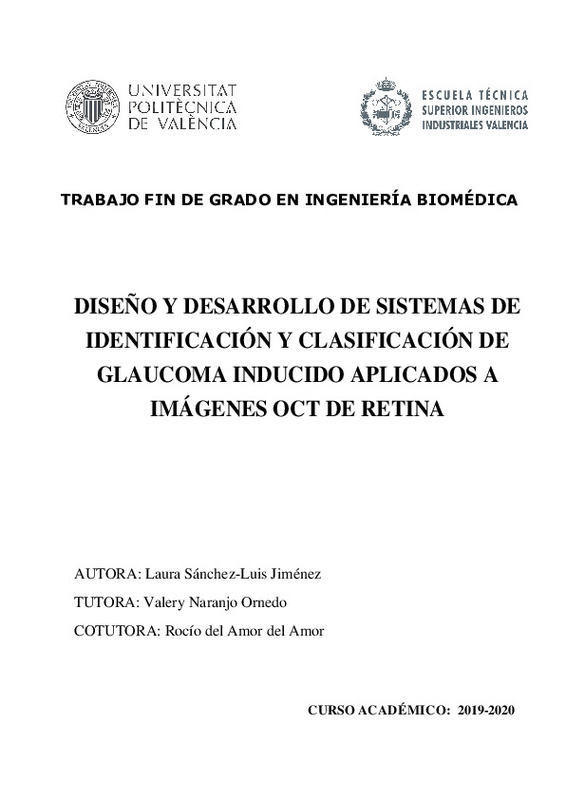JavaScript is disabled for your browser. Some features of this site may not work without it.
Buscar en RiuNet
Listar
Mi cuenta
Estadísticas
Ayuda RiuNet
Admin. UPV
Diseño y desarrollo de sistemas de identificación y clasificación de glaucoma inducido aplicados a imágenes OCT de retina
Mostrar el registro sencillo del ítem
Ficheros en el ítem
| dc.contributor.advisor | Naranjo Ornedo, Valeriana
|
es_ES |
| dc.contributor.advisor | Amor del Amor, María Rocío del
|
es_ES |
| dc.contributor.author | Sánchez-Luis Jiménez, Laura
|
es_ES |
| dc.date.accessioned | 2020-07-24T15:47:04Z | |
| dc.date.available | 2020-07-24T15:47:04Z | |
| dc.date.created | 2020-07-08 | |
| dc.date.issued | 2020-07-24 | es_ES |
| dc.identifier.uri | http://hdl.handle.net/10251/148649 | |
| dc.description.abstract | [ES] La tomografía de coherencia óptica (OCT) es una técnica de diagnóstico por imagen no invasiva basada en el principio de interferometría de baja coherencia. La OCT es ampliamente utilizada en oftalmología ya que captura la estructura interna de la retina y permite monitorizar su posible daño. Un ejemplo de su uso en oftalmología se encuentra en el estudio del glaucoma. El glaucoma es la principal causa de ceguera en todo el mundo. Esta enfermedad se caracteriza por causar un daño estructural y funcional progresivo en la cabeza del nervio óptico retiniano, lo que se traduce en la pérdida de espesor de algunas de las capas retinianas, entre ellas la capa de fibras del nervio óptico (RNFL), que es el objeto de estudio en este trabajo. El estudio del glaucoma en modelos animales es fundamental para entender su sintomatología y estudiar los posibles fármacos que pueden ser efectivos en esta enfermedad. Diversas técnicas se han utilizado para la estimulación del glaucoma en modelos animales. Entre ellas destaca la inyección de endotelina¿1 (ET-1) y la de N-metil-d-aspártico, comúnmente denominada como NMDA. El principal objetivo de este TFG reside en el desarrollo de algoritmos que permitan identificar el daño retiniano causado por los fármacos ET-1 y NMDA en modelos de roedores. De esta forma, se identificará qué fármaco es más efectivo para la estimulación del glaucoma y, mediante algoritmos de machine learning, se llevará a cabo una distinción entre sujetos control y aquellos a los que se le ha inducido glaucoma. Para ello, se partirá de varias bases de datos de retina de roedores que serán segmentadas con métodos automáticos con el objetivo de disponer la capa RNFL de la retina para su posterior análisis. | es_ES |
| dc.description.abstract | [EN] Optical coherence tomography (OCT) is a non-invasive imaging technique based on the principle of low coherence interferometry. OCT is widely used in ophthalmology since it captures the internal structure of the retina and allows monitoring of its possible damage. An example of its use in ophthalmology is found in the study of glaucoma. Glaucoma is the leading cause of blindness worldwide. This disease is characterized by causing progressive structural and functional damage to the head of the retinal optic nerve, which results in the loss of thickness of some of the retinal layers, including the retinal nerve fiber layer (RNFL), which is the object of study in this project. The study of glaucoma in animal models is essential to understand its symptoms and to study the possible drugs that may be effective in this disease. Various techniques have been used for the stimulation of glaucoma in animal models. Notable among these is the injection of endothelin ¿ 1 (ET-1) and that of N-methyl-d-aspartic acid, commonly called NMDA. The main objective of this Bachelor Thesis lies in the development of algorithms to identify retinal damage caused by the ET-1 and NMDA drugs in rodent models. In this way, we will identify which drug is most effective in stimulating glaucoma and, through machine learning algorithms, a distinction will be made between control subjects and those who have been induced glaucoma. To do this, several rodent retina databases will be used, which will be segmented with automatic methods in order to arrange the RNFL layer of the retina for subsequent analysis. | es_ES |
| dc.format.extent | 80 | es_ES |
| dc.language | Español | es_ES |
| dc.publisher | Universitat Politècnica de València | es_ES |
| dc.rights | Reserva de todos los derechos | es_ES |
| dc.subject | Tomografía de coherencia óptica | es_ES |
| dc.subject | Glaucoma | es_ES |
| dc.subject | Capa de fibras del nervio óptico | es_ES |
| dc.subject | Endotelina¿1 | es_ES |
| dc.subject | N-metil-d-aspártico | es_ES |
| dc.subject | Optical coherence tomography | es_ES |
| dc.subject | Retinal nerve fiber layer | es_ES |
| dc.subject | Endothelin-1 | es_ES |
| dc.subject | N-methyl-d-aspartic | es_ES |
| dc.subject.classification | TEORIA DE LA SEÑAL Y COMUNICACIONES | es_ES |
| dc.subject.other | Grado en Ingeniería Biomédica-Grau en Enginyeria Biomèdica | es_ES |
| dc.title | Diseño y desarrollo de sistemas de identificación y clasificación de glaucoma inducido aplicados a imágenes OCT de retina | es_ES |
| dc.type | Proyecto/Trabajo fin de carrera/grado | es_ES |
| dc.rights.accessRights | Abierto | es_ES |
| dc.contributor.affiliation | Universitat Politècnica de València. Departamento de Comunicaciones - Departament de Comunicacions | es_ES |
| dc.contributor.affiliation | Universitat Politècnica de València. Escuela Técnica Superior de Ingenieros Industriales - Escola Tècnica Superior d'Enginyers Industrials | es_ES |
| dc.description.bibliographicCitation | Sánchez-Luis Jiménez, L. (2020). Diseño y desarrollo de sistemas de identificación y clasificación de glaucoma inducido aplicados a imágenes OCT de retina. http://hdl.handle.net/10251/148649 | es_ES |
| dc.description.accrualMethod | TFGM | es_ES |
| dc.relation.pasarela | TFGM\130565 | es_ES |
Este ítem aparece en la(s) siguiente(s) colección(ones)
-
ETSII - Trabajos académicos [10404]
Escuela Técnica Superior de Ingenieros Industriales






